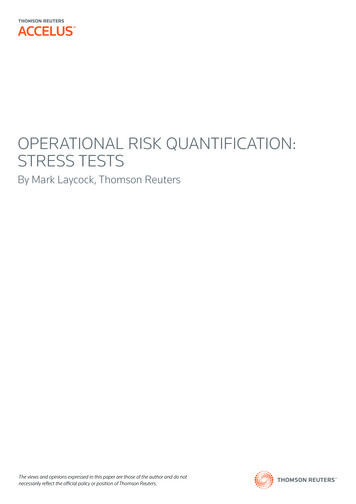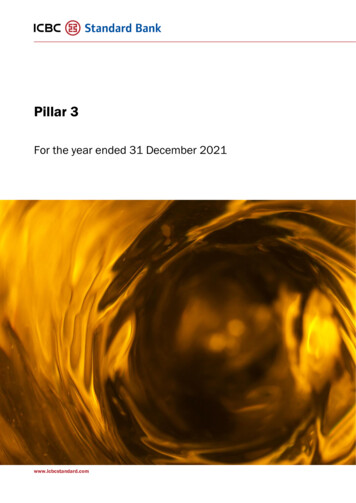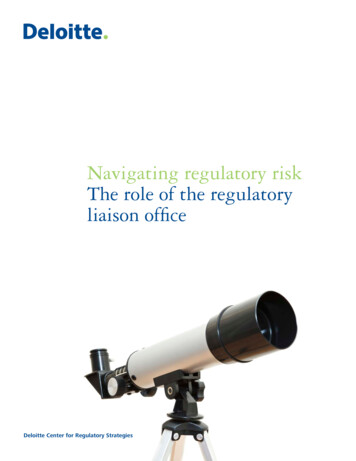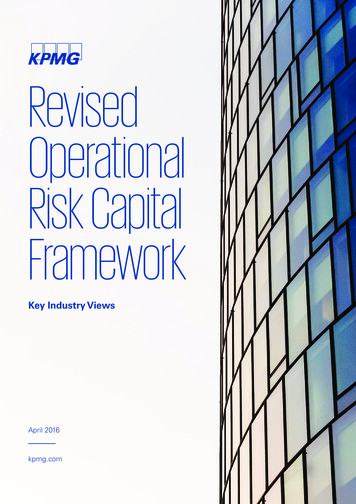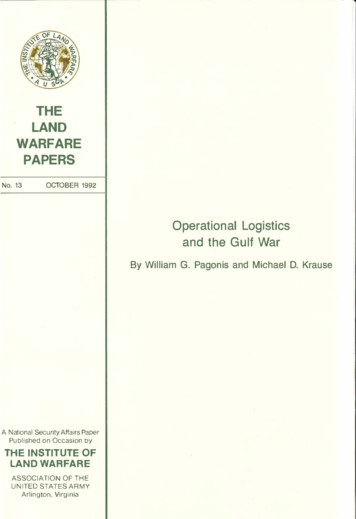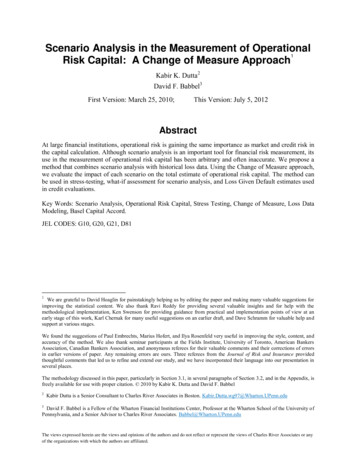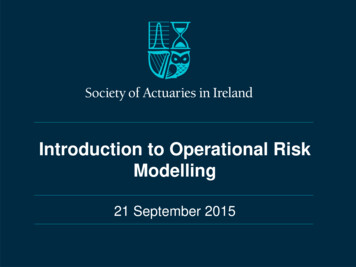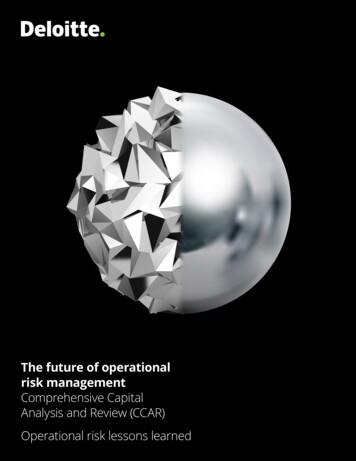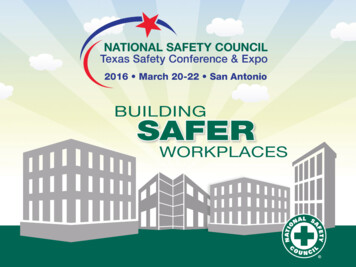
Transcription
OPERATIONAL RISK & REGULATORYCHANGE MANAGEMENT
Speaker: Ed SattarEd Sattar is the CEO of 360training and founder of 360factors, an operational risk andcompliance management software company. For more than a decade, Ed has madesignificant professional contributions to the regulatory compliance space across multipleindustries. His experiences include extensive research and consulting for regulatorycompliance consulting firms and training providers as well as state and federal regulatoryagencies. During his tenure in the risk and regulatory compliance workflow automation andeTraining space, he has identified key criteria and compliance standards that are currentlybeing published and implemented.Ed Sattar has been nominated for the Ernst & Young Entrepreneur of the Year award threetimes and was among the top seven finalists in 2009. He has appeared on the Deloitte Fast50 as the leader of the 6th fastest growing company in Texas and got the companies listed inInc 5000 several times as one of the fastest growing companies under his leadership.Ed studied Electrical Engineering and Finance at the University of Texas at Austin.
Effective OperationalRisk Management & Three P’sProfitPlanetPeople
Outline Operational Risk & Regulatory Trends Why Automate an Operational Risk and Regulatory Change Management System Operational Risk and Compliance Management Model & Methodology How to Implement an Operational Risk and Compliance Management System Can Automation and Software Increase Operational Excellence and Reduce Risk & Cost?
Operational Risk & Regulatory Trends
Rising Regulations and Cost
Regulatory Change is SignificantlyImpacting Operational RiskSource: Davis, Polk Dodd-Frank Infographics
Automate Regulatory ComplianceThrough SoftwareBENEFITS OF AN INTEGRATED MANAGEMENT SYSTEMSource: Global survey by KPMG, Inc
Operational risk TrendsTop Operational Risk TrendsChanges in Legislation and Regulations27 %Business Interruption (safety, environment, disruption,supply chain)33%Loss of Reputation & Brand30%Cyber Security10%Source: Davis, Alliance Global Corporate
Managing Your OperationsSeamlessly While ReducingRisk
Why Automate an OperationalRisk & Regulatory ChangeManagement System
Four Reasons to AutomateOperational Risk & RegulatoryChange Management1.Regulatory and Asset Intensive Organization2.Understanding Regulations- Either Over Complying or Under Complying3.Lack of Automation in Streamlining Day-to-Day Compliance, Event and IncidentManagement with Respect to Regulatory Change Management4.Ability to React Quickly- Tracking and Monitoring Non-Compliance Items Such as Events,Incidents, Audits & Investigations
Reasons to AutomateOperational Risk & RegulatoryChange ManagementOther Industry Pain Points Understanding RegulationsRegulatory Change ManagementRegulatory ApplicabilityDay-to-Day Compliance TaskingEvent-Driven Compliance TaskingIncident Management and RootCause Analysis Predictive Risk AnalysisCorrective and Preventive ActionsPolicy and Procedure ManagementAudit ManagementSustainabilityTraining ManagementMultiple Tools to address Reg Compliance
Operational Risk andCompliance Management Model
Operational Risk and ComplianceManagement Model – Five Steps1.WHY Regulatory change management2.WHAT Risk and internal controls3.HOW Operational excellence and processes4.WHERE Location / assets5.WHO Defining & mapping roles / key management functions to metrics & P&L
OPERATIONL RISK &COMPLIANCE gementOrganization– Roles andKeyManagementFunctionsRisks &InternalControls
How to Implement an OperationalRisk and Compliance ManagementSystem
Step 1- Requirements KnowledgeBase & TaxonomyCOMPONENTS OF REQUIREMENTS KNOWLEDGE BASE1. Library - Regulations, standards, requirements andobjectivesBusinessProcessWHY2. Translate regulatory requirements into action, evidence,subject, and frequency3. Monitor regulatory change4. Regulations in effect to proposed5. Mapping- regulatory requirements mapped to CAPA ,policy procedures and evidence, risks and auditsLocations andAssetsRequirementsKnowledge Based&Taxonomy6. Regulation applicabilityRoles andResponsibilitiesRisk andInternalControls
Step 2- Risk & Internal Controls1. What is impacted? Environmental Risk Financial Risk Legal Risk Reputational Risk Operational Risk2. Define risk levels Which details are impacting factors? Is it based on a systematic process allowing theorganization to prioritize more efficiently? Effectively assesses issues requiring immediateaction.3. Define internal controls Process Procedures Risk Assessments Tasks TrainingOperationalExcellence andWorkflowWHATLocation/ AssetsRequirementsKnowledge Based &TaxonomyReporting –Roles and KeymanagementFunctionsRisk andInternalControls
High ComplexityStep 2- Risk & Internal ControlsRoles andResponsibilitySimple Knowledge Based &TaxonomyReportingSmall WorkforceLarge WorkforceRisk andInternalControls
Step 3- Business ProcessesHOWOperationalExcellenceand BusinessProcesses1. How2. Compliance routines process aroundsites, assets, and events into a coherentsystem3. System enabled reports4. Manual vs. automation owledge Based &TaxonomyReportingRisk and InternalControls
Step 3- Business ProcessesPROCESSESS THAT CAN BE AUTOMATEDHOWCorrective Action to Increase Speed,Eliminate Waste and Cut CostsBusinessProcessScheduling, Tasking and TrackingEmbed Transparency and AccountabilityManagement of ledge Based &TaxonomyPROCESSESS THAT CAN’T BE AUTOMATEDTranslation of RequirementsSubject Matter ExpertiseReportingRisk and InternalControls
Step 4. Location & AssetsBusinessProcess1. Where is compliance done.2. Compliance done at the site and asset levelWHERE3. Ability to determine which regulations are applicable ata location/siteLocation /AssetsRequirementsKnowledge Based &TaxonomyRoles &ResponsibilityRisk andInternalControls
Step 5. Roles & Responsibility1. EHS Regulatory Compliance GovernanceStructure - Clarify roles, responsibilitiesand functionsBusinessProcess2 Clarify resource capabilities andescalation procedures, as well as theinformation and reporting systems.3. This last step ties in all four steps of themodel.Location / AssetsRequirementsKnowledge Based &Taxonomy4. Is there a specific role and responsibilitystructure or can it vary by organization andindustry?Roles &ResponsibilityRisk and InternalControlsWHO
Step 5. Roles & ResponsibilityCOMPONENTS OF ROLES AND RESPONSIBILITES1. Key Roles and StructureBusinessProcessExample- EHS Mgrs, Owners2. Key FunctionsExample- EHS, OSHA. NERC compliance3. Key ActionsExample: Compliance, Quality,SustainabilityLocation /AssetsRequirementsKnowledge Based &Taxonomy4. Outcome / ResultsRoles &ResponsibilityRisk andInternalControls
Can Automation and SoftwareIncrease Operational Excellenceand Reduce Risks and OverallCost?
Automate Regulatory ComplianceThrough SoftwareBusinessProcess1. Is technology perceived as a catalyst forgrowth and performance?2. Are people or technology barriers toRegulatory Compliance tandardsBusinessRequirementsOrganizationRisks &Controls
High ComplexityStep 2 - Risk & Internal ControlsStrongTechnologyModerateTechnologyLow ComplexityWeak Technology Documents &spreadsheets Email for workflow &tasks No audit trail oraccountabilitySmall Workforce Basic workflow &task management No regulatorycontent feeds Audit trail foraccountability Enterprise workflow Integrated andactionable regulatorycontent with policymanagement Closed loop process– everythingintegrated into oneplatform Indexing ofregulations to otherpoliciesLarge Workforce
Predict360 REGULATORY COMPLIANCE ARCHITECTURE
People, Planet and Profit
RECAP1. Regulations are growing at an increasing rate, causing the costto go up2. Enterprise risk and regulatory change management model3. This model drives operational excellence across all functionaldepartments4. Complex vs. non-complex organization – risk increases5. Automation and technology drives operational excellence6. Profit, people and planet are happy
2. Enterprise risk and regulatory change management model 3. This model drives operational excellence across all functional departments 4. Complex vs. non-complex organization -risk increases 5. Automation and technology drives operational excellence 6. Profit, people and planet are happy

